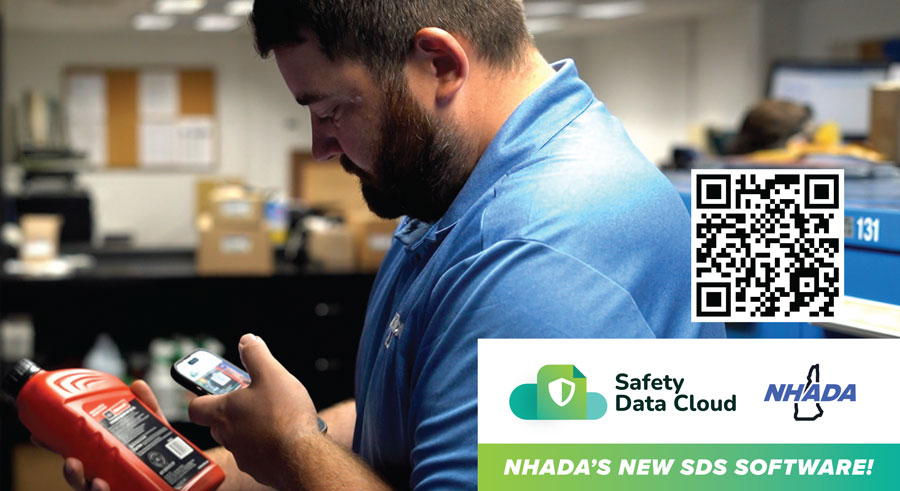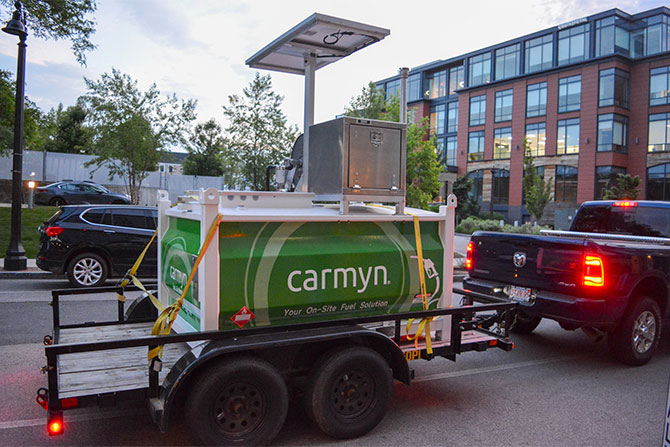Request more info about NHADA’s new SDS management software.
Auto dealerships and service centers work with a wide range of hazardous materials — from brake cleaners and solvents to paints, refrigerants and fuels. Federal OSHA regulations and New Hampshire’s Workers’ Right-to-Know Law require strict management of these chemicals, including up-to-date Safety Data Sheets (SDS) and a complete inventory.
Federal Requirements
Under OSHA’s Hazard Communication Standard (29 CFR 1910.1200), every employer must:
- Maintain a written Hazard Communication program listing all hazardous chemicals on site.
- Keep an SDS for each hazardous chemical and make them readily accessible to employees on every shift.
- Ensure proper labeling of shipped and workplace containers.
- Train employees at hire and when new hazards are introduced.
- Retain SDS or exposure records for 30 years under OSHA recordkeeping rules (29 CFR 1910.1020).
Facilities exceeding certain quantities must also comply with the Emergency Planning and Community Right-to-Know Act (EPCRA), which requires submitting chemical inventories (Tier II reports) by March 1 each year.
New Hampshire-Specific Requirements
In addition to federal law, New Hampshire’s Workers’ Right-to-Know Law (RSA 277-A) requires employers to:
- Respond to SDS requests from employees within 72 hours.
- Send SDS, including storage locations and extinguishing agents, to the local fire department.
- Post workplace hazard notices where employees can see them.
- Maintain SDS for 30 years, submitting them to the New Hampshire Department of Labor if the business closes or relocates.
The Compliance Challenge for Dealerships
Managing multiple service bays, dozens of chemical products and constant product turnover can make compliance a moving target. Paper SDS binders become outdated quickly, and tracking inventory quantities for EPCRA reporting is tedious without a system.
NHADA’s Solution: Safety Data Cloud
This year, NHADA teamed up with Direct Link Corporation, an automotive software company with over 30 years of experience, to build a program to streamline SDS management. It was built to take the hassle — and risk — out of chemical compliance for your businesses. Here’s how it works.
Managed Accounts
Members of the NHADA Workers’ Compensation Trust will have their chemical inventories fully managed by their loss prevention representative. This means after your account has been created, we’ll be scanning your products to build your inventory and training your staff on the utilization of the program.
Key features include:
- Multi-Store Management: Navigate between your locations, seamlessly managing and viewing your chemical inventory.
- Barcode Scanning: Scan product barcodes to quickly add new data sheets to your library.
- QR Code Poster: Post a live QR code in your store for quick access to your chemical inventory.
Self-Managed Accounts
If you aren’t a member of the NHADA Workers’ Compensation Trust, this program is for sale and available to the public for use. For an annual rate of $349, an NHADA employee can set your account up and even take inventory. By automating SDS access, inventory tracking and reporting prep, Safety Data Cloud helps businesses focus on service — not scrambling during an inspection or emergency.
For questions, please contact safety@nhada.com.









